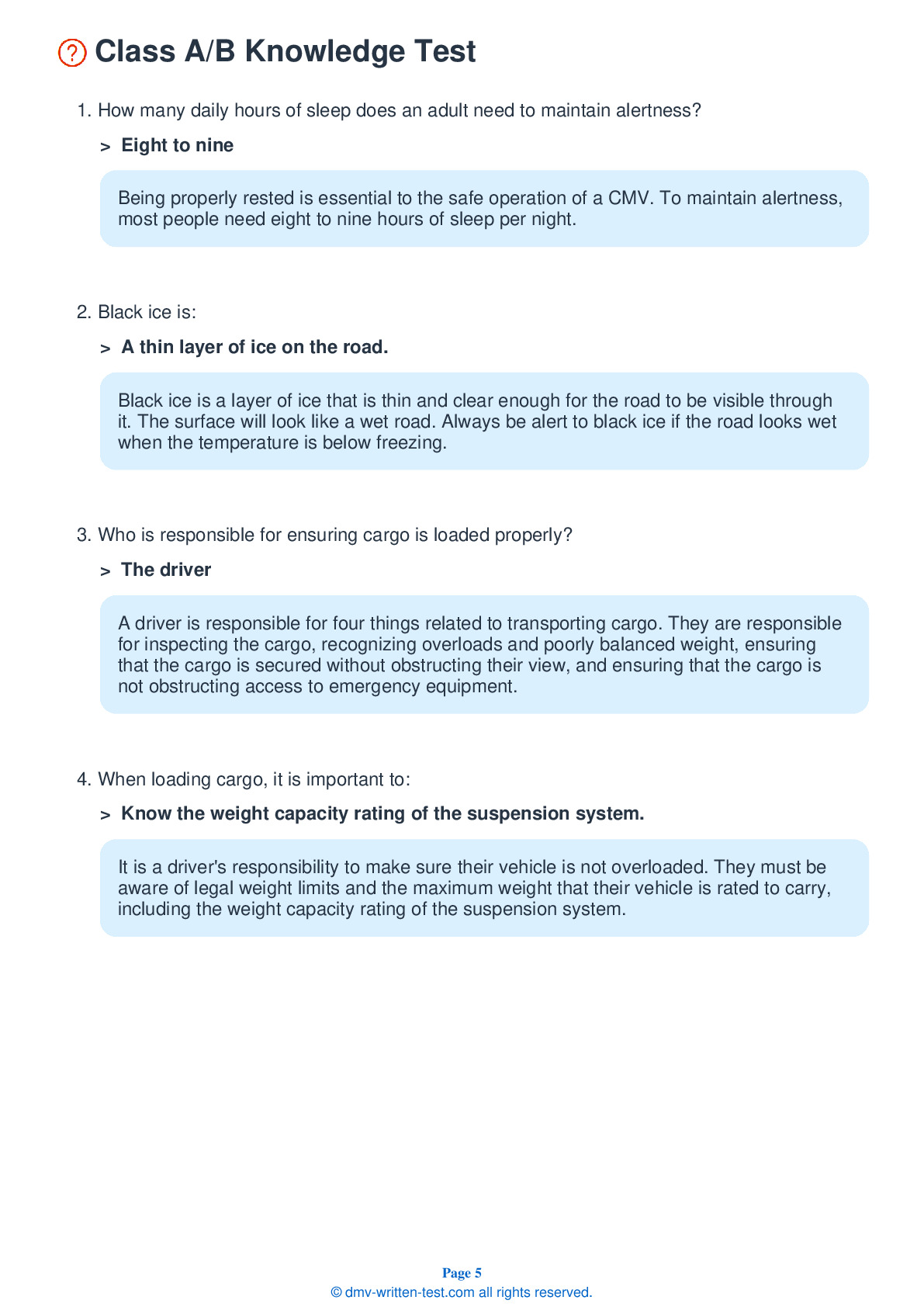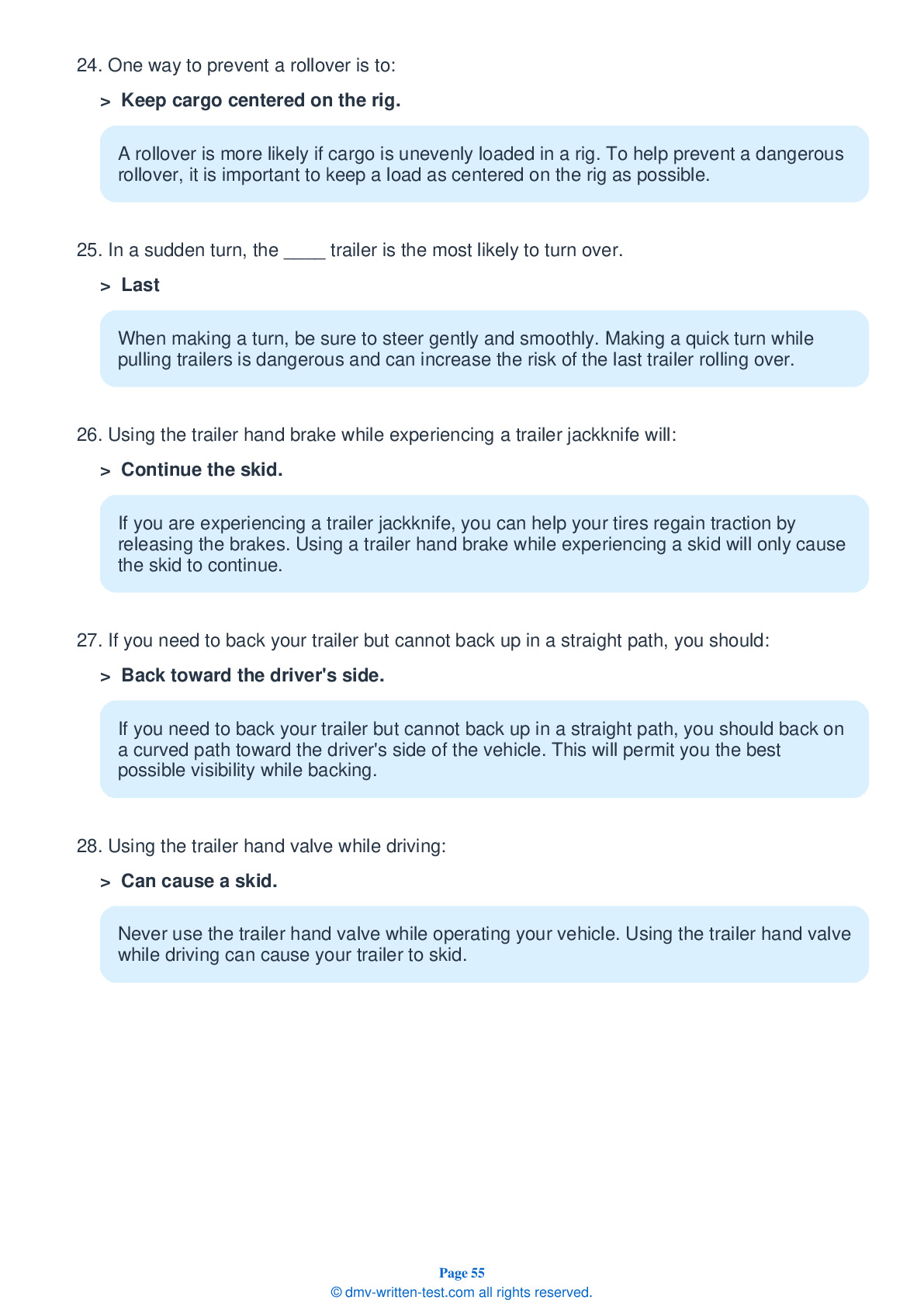Knowledge Test Class B
This license is required for driving a single vehicle with a GVWR of more than 26,001 pounds, and a trailer not to exceed 10,000 pounds gross vehicle weight rating, or a vehicle designed to transport 24 or more people (including the driver). To receive this license, applicants must pass a 50-question test. To pass, applicants must answer 40 questions correctly. Each question has three possible answer choices. Test questions come from the Alaska Commercial Driver License Manual. Questions come from chapters covering: Introduction, Driving Safely, Transporting Cargo Safely, Air Brakes (if applicable), Pre-Trip Vehicle Inspection Test, Basic Vehicle Control Skills Test and On-Road Driving.. Endorsements that may be used with a Class B CDL are: Hazardous materials, Tank, Passenger, HazMat and Tank, Air Brakes and School bus.
29. Which of the following is acceptable if found during a pre-trip inspection?
Be sure to thoroughly inspect your tires before a trip. Tire sizes should not be mismatched, and tires should not be cut, cracked, or otherwise damaged in any way.
30. A cracked rim should be:
A driver should inspect wheels before a drive, specifically looking for damage on the wheels and rims. Wheels or rims that have had welding repairs are not safe for use.
31. Steering wheel play should be no more than:
A steering wheel should have no more than 10 degrees of play. This is equal to about two inches of movement at the rim of a 20-inch wheel. If there is more play than this, it may be difficult to steer.
32. You should ____ if the low pressure warning signal activates while you are driving.
If the low pressure warning signal activates while you are driving, it is important that you safely exit the roadway as soon as possible and park your vehicle. If the air pressure gets too low, the brakes will no longer work well enough for you to stop safely.
33. A distracted driver:
Distracted drivers perceive hazards on the road more slowly than drivers who are focused, or they do not perceive hazards at all.
34. Failing to drain air tanks could result in:
In an air brake system, the air tanks must be periodically drained to remove accumulations of water and compressor oil. If water is not removed, it could freeze in cold weather and cause brake failure.
35. After a tire has been changed, the driver should stop after a short distance to:
After changing a tire, you should stop a short distance later to recheck the tightness of the tire's lug nuts.
Frequently Asked Questions
To obtain a Class B CDL in Alaska, you must first pass a written knowledge test and obtain a learner's permit. You must then complete a CDL training program or obtain the necessary knowledge and skills through other means, such as on-the-job training or self-study.
Once you have completed the necessary training and feel ready to take the skills test, you must schedule an appointment at an approved CDL testing location. The skills test will consist of a pre-trip inspection, basic control skills test, and an on-road driving test.
If you pass the skills test, you will receive your Class B CDL license. It is important to note that additional endorsements may be required depending on the type of vehicle you plan to operate (e.g. passenger transport, hazardous materials transport).
- Straight trucks (such as delivery trucks and dump trucks) with a gross vehicle weight rating (GVWR) of 26,001 pounds or more
- Buses designed to transport 16 or more passengers (including the driver)
- Combination vehicles, such as a tractor-trailer combination, where the trailer has a GVWR of less than 10,000 pounds
It's important to note that additional endorsements may be required depending on the type of vehicle you plan to operate. For example, if you plan to transport hazardous materials or operate a passenger vehicle, you will need additional endorsements on your CDL.
1. Age: You must be at least 18 years of age to obtain a Class B CDL. However, if you plan to operate a vehicle that transports hazardous materials or is designed to transport 16 or more passengers (including the driver), you must be at least 21 years of age.
2. Valid driver's license: You must have a valid driver's license issued by the state of Alaska.
3. Medical certification: You must provide proof of a current medical certification that meets the requirements set by the Federal Motor Carrier Safety Administration (FMCSA).
4. Knowledge test: You must pass a written knowledge test that covers topics such as general driving knowledge, safe driving practices, and specific knowledge related to operating a Class B vehicle.
5. Skills test: You must pass a skills test that includes a pre-trip vehicle inspection, basic control skills test, and an on-road driving test.
6. Training: You must complete an approved CDL training program or obtain the necessary knowledge and skills through other means, such as on-the-job training or self-study.
It is important to note that additional requirements may apply depending on the type of vehicle you plan to operate and any endorsements you may need on your CDL.
1. Passenger endorsement (P): Required if you plan to drive a vehicle designed to transport 16 or more passengers (including the driver).
2. School bus endorsement (S): Required if you plan to drive a school bus.
3. Tanker endorsement (T): Required if you plan to transport liquids or gases in bulk in a tank vehicle.
4. Hazardous materials endorsement (H): Required if you plan to transport hazardous materials as defined by federal law.
In addition to these endorsements, other endorsements may be required depending on the specific type of cargo or vehicle you plan to operate. It's important to note that endorsements may require additional testing and fees, and they must be renewed periodically.
1. Pre-trip inspection: You will be asked to inspect your vehicle and identify any safety concerns or maintenance issues before starting the engine. This includes checking the lights, brakes, tires, and other critical components.
2. Basic control skills: You will be asked to demonstrate your ability to control the vehicle in a variety of situations, such as backing up, turning, and parking.
3. Road test: You will be asked to drive the vehicle on public roads while demonstrating safe driving practices, such as lane changes, turns, and acceleration/deceleration.
During each part of the test, you will be evaluated on your ability to follow proper procedures, maintain control of the vehicle at all times, and demonstrate safe driving practices. It's important to note that the specific requirements for the Class B CDL skills test may vary by state, so it's always a good idea to check with your local DMV or licensing agency for detailed information.
1. Automatic transmission restriction: If you took your skills test in a vehicle with an automatic transmission, your license will be restricted to driving only vehicles with automatic transmissions.
2. Airbrake restriction: If you did not pass the air brake component of your skills test or did not take the air brake test, your license will be restricted to driving vehicles without air brakes.
3. Passenger vehicle restriction: If you did not pass the passenger vehicle endorsement portion of your skills test, your license will be restricted from operating vehicles designed to carry more than 15 passengers.
4. Hazardous materials restriction: If you did not pass the hazardous materials endorsement portion of your skills test, your license will be restricted from transporting hazardous materials.
It's important to note that these restrictions may vary by state and may also depend on the specific endorsements or qualifications you hold. Additionally, violating any of these restrictions can result in penalties or loss of your CDL.
If you are not comfortable taking the test in English, you may be able to bring an interpreter with you to assist with translation. However, it's important to check with your local DMV or licensing agency beforehand to find out their policies on interpreters or non-English language options for the test.
It's also worth noting that even if the written test is available in another language, you will still need to demonstrate your ability to read and understand English for other aspects of the licensing process, such as the road test or pre-trip inspection.
Some examples of accommodations that may be available for the written test include:
- Extended time to take the test
- A separate testing room or a quiet environment
- Assistive technology or software
- A reader or a scribe
To request accommodations, you will need to contact your local DMV or licensing agency and provide documentation of your disability. The documentation should include information about your diagnosis, how your disability affects your ability to take the test, and what accommodations are recommended by your healthcare provider.
It's important to make your request for accommodations well in advance of your scheduled test date to allow time for processing and arranging the necessary accommodations.
In most cases, you will need to pay a fee each time you retake the written test. It's important to study the material thoroughly and prepare adequately before retaking the test to improve your chances of passing.
If you fail the written test multiple times, you may be required to complete additional training or education before being allowed to retake the test. Additionally, if you fail the road test (driving portion) after passing the written test, you may need to retake both tests together.
It's important to remember that passing the written test is just one step in obtaining a Class B CDL. You will also need to pass a road test and meet other requirements, such as age and medical standards, before being granted a CDL.




